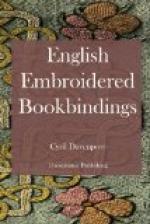An embroidered book designed in a manner which is characteristic of a gold tooled book is found but rarely. An instance of this however is found on a copy of The Commonplaces of Peter Martyr, translated by Anthonie Marten, and printed in London in 1583. It is covered in blue purple velvet measuring 13-1/2 by 9 inches, and the design upon it is a broad outer border doubly outlined with a curious and effective braid, apparently consisting of a close series of small silver rings, but really being only a silver spiral flattened out. This border is dotted at regular intervals with star-shaped clusters of small pieces of silver guimp symmetrically arranged. The centre of the inner panel is a diamond-shaped ornament made with similar ‘ring’ braid and small pieces of silver guimp, and the corner-pieces are quarter circles worked in the same way. This design of centre-piece and corner-pieces is distinctly borrowed from leather work, and I have never seen another example of the kind executed in needlework. The colouring of this book is very good, the purple and silver harmonising in a very pleasing manner.
[Illustration: 27—Biblia. Antverpiae, 1590.]
Biblia. Antverpiae, 1590.
A beautiful binding of green velvet covers a Bible printed at Antwerp in 1590, measuring 7 by 4 inches. The design is the same on both sides, and the book was apparently bound for ‘T. G.,’ whose initials are worked into the design; a conventional arrangement of curving stems and flower forms worked in gold cord, guimp, and small pearls thickly encrusted; the same on both boards. The centre is a large conventional flower, in form resembling a carnation, with serrated petals, having a garnet below it, and flanked by the letters T. G., all thickly worked with reed pearls. In each corner is a smaller flower—conventionalised forms probably of honeysuckle and rose—joined together by curving stems of gold cord, filled out with leaves and arabesques, all together forming a very decorative panel. The outer border is richly worked with leaves and arabesques in guimp and pearls, the outer line of gold cord being ornamented with small triple points marked with pearls. The back is divided into three spaces by curving lines of gold cord, and in each of these spaces is worked one of the same conventionalised flower forms as occur on the boards, i.e. a honeysuckle, cornflower, and rose, with leaves and smaller curves of gold cord.
[Illustration: 28—Udall, Sermons. London, 1596. (From a drawing).]
The ground of the entire work is freely ornamented with gilt spangles held down by small pieces of guimp, and with single pearls; the larger of these are enclosed within circles of guimp, the smaller are simply sewn on one by one.
There are remains of gilt clasps on the front edges of each of the boards, and the edges of the leaves are gilt and gauffred, with a little pale colour.




